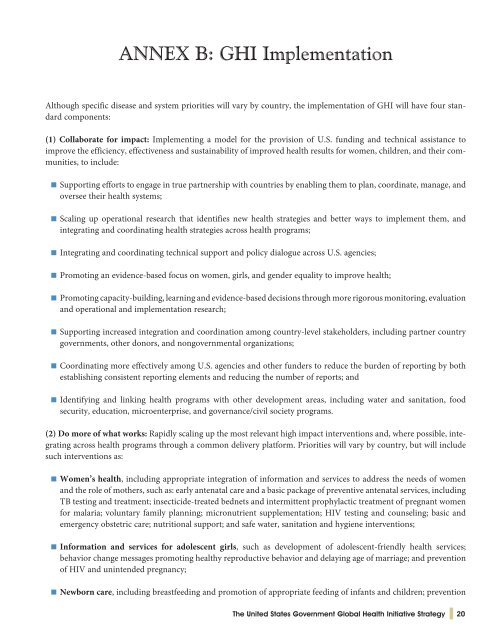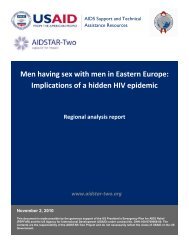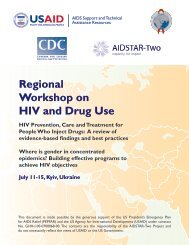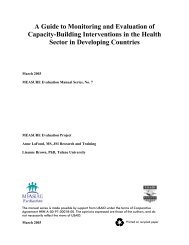The United States Government Global Health Initiative - Centers for ...
The United States Government Global Health Initiative - Centers for ...
The United States Government Global Health Initiative - Centers for ...
You also want an ePaper? Increase the reach of your titles
YUMPU automatically turns print PDFs into web optimized ePapers that Google loves.
ANNEX B: GHI Implementation<br />
Although specific disease and system priorities will vary by country, the implementation of GHI will have four standard<br />
components:<br />
(1) Collaborate <strong>for</strong> impact: Implementing a model <strong>for</strong> the provision of U.S. funding and technical assistance to<br />
improve the efficiency, effectiveness and sustainability of improved health results <strong>for</strong> women, children, and their communities,<br />
to include:<br />
Supporting ef<strong>for</strong>ts to engage in true partnership with countries by enabling them to plan, coordinate, manage, and<br />
oversee their health systems;<br />
Scaling up operational research that identifies new health strategies and better ways to implement them, and<br />
integrating and coordinating health strategies across health programs;<br />
Integrating and coordinating technical support and policy dialogue across U.S. agencies;<br />
Promoting an evidence-based focus on women, girls, and gender equality to improve health;<br />
Promoting capacity-building, learning and evidence-based decisions through more rigorous monitoring, evaluation<br />
and operational and implementation research;<br />
Supporting increased integration and coordination among country-level stakeholders, including partner country<br />
governments, other donors, and nongovernmental organizations;<br />
Coordinating more effectively among U.S. agencies and other funders to reduce the burden of reporting by both<br />
establishing consistent reporting elements and reducing the number of reports; and<br />
Identifying and linking health programs with other development areas, including water and sanitation, food<br />
security, education, microenterprise, and governance/civil society programs.<br />
(2) Do more of what works: Rapidly scaling up the most relevant high impact interventions and, where possible, integrating<br />
across health programs through a common delivery plat<strong>for</strong>m. Priorities will vary by country, but will include<br />
such interventions as:<br />
Women’s health, including appropriate integration of in<strong>for</strong>mation and services to address the needs of women<br />
and the role of mothers, such as: early antenatal care and a basic package of preventive antenatal services, including<br />
TB testing and treatment; insecticide-treated bednets and intermittent prophylactic treatment of pregnant women<br />
<strong>for</strong> malaria; voluntary family planning; micronutrient supplementation; HIV testing and counseling; basic and<br />
emergency obstetric care; nutritional support; and safe water, sanitation and hygiene interventions;<br />
In<strong>for</strong>mation and services <strong>for</strong> adolescent girls, such as development of adolescent-friendly health services;<br />
behavior change messages promoting healthy reproductive behavior and delaying age of marriage; and prevention<br />
of HIV and unintended pregnancy;<br />
Newborn care, including breastfeeding and promotion of appropriate feeding of infants and children; prevention<br />
<strong>The</strong> <strong>United</strong> <strong>States</strong> <strong>Government</strong> <strong>Global</strong> <strong>Health</strong> <strong>Initiative</strong> Strategy ▌20









